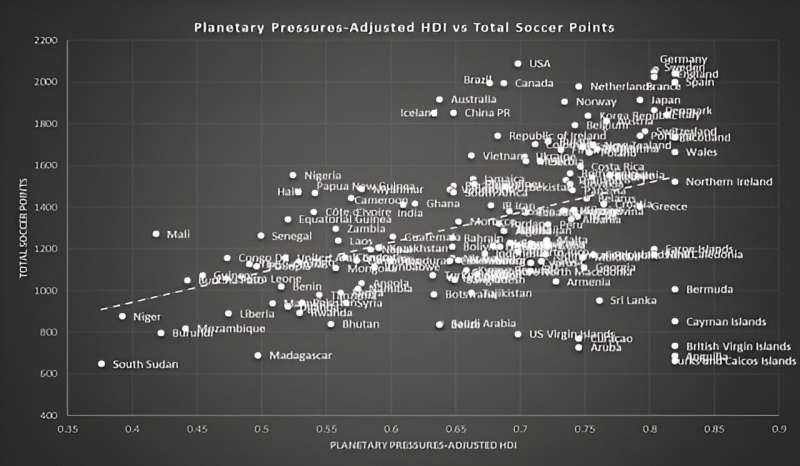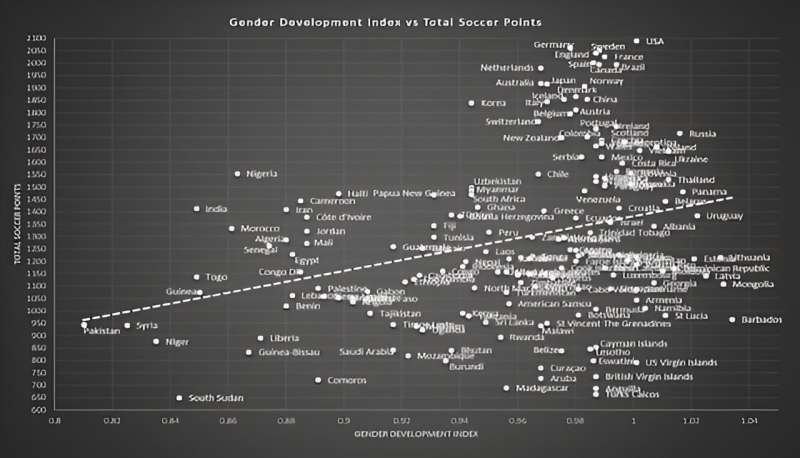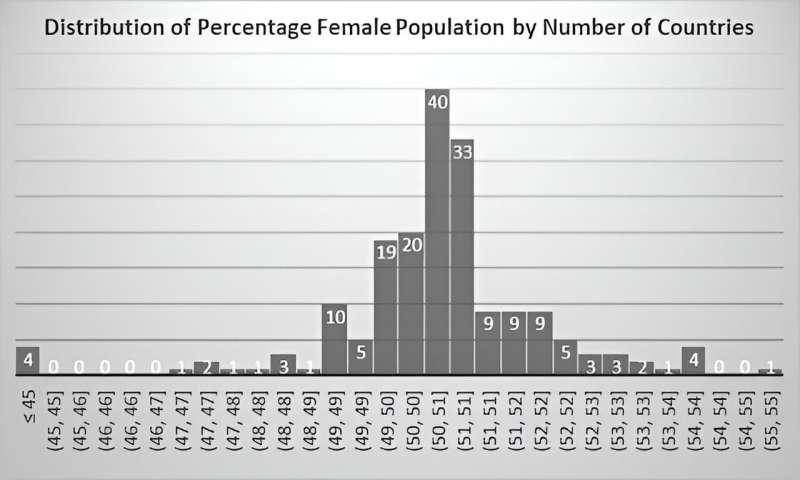This article has been reviewed according to Science X's editorial process and policies. Editors have highlighted the following attributes while ensuring the content's credibility:
fact-checked
trusted source
written by researcher(s)
proofread
FIFA Women's World Cup successes reflect gender gap differences between countries

The recent FIFA Women's World Cup was nothing short of exhilarating, with the final match between Spain's victorious La Roja team versus England's Lionesses leaving fans on the edge of their seats.
A record-breaking two million fans attended the games in Australia and New Zealand, serving as a testament to the heights women can reach with the right opportunities and support.
But this year's Women's World Cup also signified a broader shift beyond the boundaries of the playing field. The games were accompanied by cries for equal treatment of women in sports and far beyond.
By examining the performances of countries that participated in the Women's World Cup, we can gain insights into the efforts countries are making to address gender inequality beyond sports.
Gender equality policies
Countries ranking highest in the Women's World Cup, such as Sweden, England, Spain and Australia, have devised policies and made investments in women and girls that go beyond women's sports.
Scandinavian countries are known for their improved conditions for women, such as more equal sharing of unpaid domestic work, although the problem is still not solved. Sweden has a National Gender Equality Policy that also includes a statement that men's violence against women must stop.
Ensuring that access to education translates to workforce opportunities, political power-sharing and equal economic benefits is also critical. England requires employers with 250 employees or more to report on their gender pay gap—an important policy that supports economic parity.
Spain has been praised for its feminist policies facilitating access to sexual and reproductive rights. Spain's Equality Law includes paternity leave, gender-balanced political representation, and equality plans to eliminate gender discrimination are required by all public and private organizations with more than 250 employees.
Australia also has a National Strategy to Achieve Gender Equality, including a Women's Economic Equality Taskforce.

Research has recommended many of the same policies these countries have embarked upon for mainstreaming gender equality elsewhere around the world.
Sustainable development
The countries that excelled in the Women's World Cup were also those that rank higher in sustainable development. This link between higher sports achievement and sustainable development makes sense, since recent research has connected higher UN Human Development Index rankings with achievement in Olympic sports and vice versa.
The Human Development Index measures things like life expectancy, education and gross national income per capita.
Women's soccer scores appear to be even more strongly related to another type of development index—the Planetary pressures-adjusted Human Development Index. This index takes into account the human impact of activities, like the amount of carbon dioxide emissions per person, on the planet.
My analysis found that a lower environmental footprint was associated with higher team success. This implies that our environmental activities affect women's capabilities to succeed—at least when national soccer scores are used as outcomes.
Gender development
My analysis found that women's soccer scores were also related to the Gender Development Index, which differs from the Human Development Index.
The Gender Development Index measures inequality between males and females across three measures: life expectancy, education and earned income. Since men and women live under different circumstances, women's issues must be specifically paid attention to. The cries for pay equity in women's soccer attest to this.
My analysis found that a higher Gender Development Index was associated with women's soccer team success. Countries that had higher Gender Development Index scores were more likely to have higher scores in soccer.

Women are half the population
The world needs to be reminded that women comprise roughly 50 percent of the world's population. Countries with more women tend to do better on soccer scores.
Developing the largest possible talent pool for women's sports would benefit from increasing numbers and the quality of those numbers. Give every girl a better chance from the beginning. Cutting down the available talent pool will not lead to positive outcomes.
Unfortunately, there is still evidence of sex-selective abortions and discrimination against girls in many countries. This not only hurts the soccer scores of these countries, according to my analysis, but also extends to other areas, like government and politics.
For example, autocracies like Russia—governments where absolute power is held by one person—often rely on the consolidation of male power to the detriment of women. Democracies, on the other hand, hinge on human rights, which include women's rights. In fact, the top-ranking women's soccer teams all come from democracies.
Continuing the fight
The story of women's soccer is one of perseverance. Although the first international soccer match between Scotland and England was in 1881, a disheartening turn of events unfolded in 1921 when the English Football Association banned women from playing. This held back women in soccer for 50 years.
It has been an uphill battle for women since then. There has been a long history of women being banned from many types of activities and realms, all of which has damaged women's development globally.
History tells us that we must be forever vigilant and continue to fight for women's rights and equality. In fact, we still have a long way to go, especially considering the way the pandemic set women back.
Improving women's circumstances requires a variety of interventions. These include enforcing equal pay and employment opportunities through legislation and changing tax laws and benefits to reinforce women as equal household partners.
Adding a "women in sports inequality" variable to the Gender Development Index may enhance our ability to measure the impacts of these changes for the progress we so desperately need to make.
Provided by The Conversation
This article is republished from The Conversation under a Creative Commons license. Read the original article.![]()



















